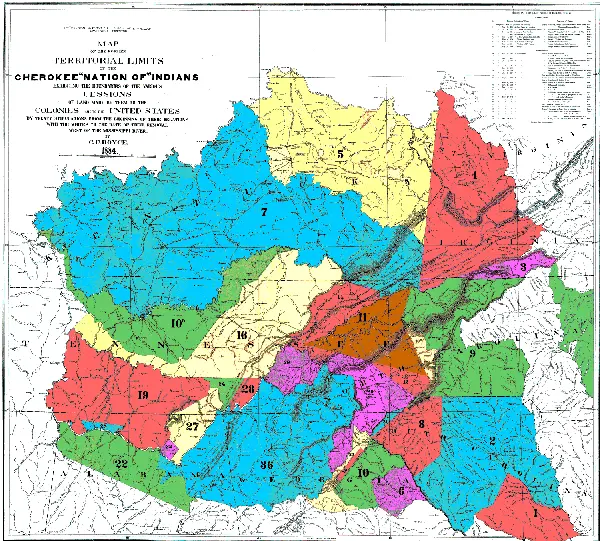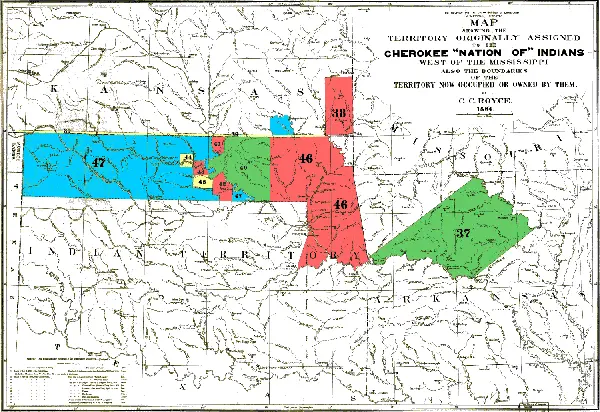The war over and the work of reconstruction commenced, found them numbering fourteen thousand impoverished, heart broken, and revengeful people. But they must work or starve, and in almost sullen despair they set about rebuilding their waste places. The situation was one calculated to discourage men enjoying a higher degree of civilization than they had yet reached, but they bent to the task with a determination and perseverance that could not fail to be the parent of success.
To-day their country is more prosperous than ever. They number twenty-two thousand, a greater population than they have had at any previous period, except perhaps just prior to the date of the treaty of 1835, when those east added to those west of the Mississippi are stated to have aggregated nearly twenty-five thousand people. 693To-day they have twenty-three hundred scholars attending seventy-five schools, established and supported by themselves at an annual expense to the nation of nearly $100,000. To-day thirteen thousand of their people can read and eighteen thousand can speak the English language. To-day five thousand brick, frame, and log houses are occupied by them; and they have sixty-four churches with a membership of several thousand. They cultivate a hundred thousand acres of land and have an additional one hundred and fifty thousand fenced. They raise annually 100,000 bushels of wheat, 800,000 of corn, 100,000 of oats and barley, 27,500 of vegetables, 1,000,000 pounds of cotton, 500,000 pounds of butter, 12,000 tons of hay, and saw a million feet of lumber. They own 20,000 horses, 15,000 mules, 200,000 cattle, 100,000 swine, and 12,000 sheep.
They have a constitutional form of government predicated upon that of the United States. As a rule, their laws are wise and beneficent and are enforced with strictness and justice. Political and social prejudice has deprived the former slaves in some instances of the full measure of rights guaranteed to them by the treaty of 1866 and the amended constitution of the nation, but time is rapidly softening these asperities and will solve all difficulties of the situation.
The present Cherokee population is of a composite character. Remnants of other nations or tribes have from time to time been absorbed and admitted to full participation in the benefits of Cherokee citizenship. The various classes may be thus enumerated:
1. The full blood Cherokees.
2. The mixed blood Cherokees.
3. The Delawares.
4. The Shawnees.
5. White men and women intermarried with the foregoing.
6. A few Creeks who broke away from their own tribe and have been citizens of the Cherokee Nation for many years.
7. A few Creeks who are not citizens, but have taken up their abode in the Cherokee country, without any rights.
8. A remnant of the Natchez tribe, who are citizens.
9. The freedmen adopted under the treaty of 1866.
10. Freedmen not adopted, but not removed as intruders, owing to an order from the Indian Department forbidding such removal pending a decision upon their claims to citizenship.
If the Government of the United States shall in this last resort of the Cherokees prove faithful to its obligations and maintain their country inviolate from the intrusions of white trespassers, the future of the nation will surely prove the capability of the American Indian under favorable conditions to realize in a high degree the possibilities of Anglo-Saxon civilization.
Table showing approximately the area in square miles and acres ceded to the United States
by the various treaties with the Cherokee Nation:
| Date of treaty. |
State where ceded lands are located. |
Area in square miles. |
Area in acres. |
| 1721 |
South Carolina |
2,623 |
1,678,720 |
| November 24, 1755 |
do |
8,635 |
5,526,400 |
| October 14, 1768 |
Virginia |
850 |
544,000 |
| October 18, 1770 |
do |
4,500 |
2,880,000 |
| West Virginia |
4,300 |
2,752,000 |
| Tennessee |
150 |
96,000 |
| Kentucky |
250 |
160,000 |
| 1772 |
do |
10,135 |
6,486,400 |
| West Virginia |
437 |
279,680 |
| Virginia |
345 |
220,800 |
| June 1, 1773 |
Georgia |
1,050 |
672,000 |
| March 17, 1775 |
Kentucky |
22,600 |
14,464,000 |
| Virginia |
1,800 |
1,152,000 |
| Tennessee |
2,650 |
1,696,000 |
| May 20, 1777 |
South Carolina |
2,051 |
1,312,640 |
| July 20, 1777 |
North Carolina |
4,414 |
2,824,960 |
| Tennessee |
1,760 |
1,126,400 |
| May 31, 1783 |
Georgia |
1,650 |
1,056,000 |
| November 28, 1785 |
North Carolina |
550 |
352,000 |
| Tennessee |
4,914 |
3,144,960 |
| Kentucky |
917 |
586,880 |
| July 2, 1791 |
Tennessee |
3,435 |
2,198,400 |
| North Carolina |
722 |
462,080 |
| October 2, 1798 |
Tennessee |
952 |
609,280 |
| North Carolina |
587 |
375,680 |
| October 24, 1804 |
Georgia |
135 |
86,400 |
| October 25, 1805 |
Kentucky |
1,086 |
695,040 |
| Tennessee |
7,032 |
4,500,480 |
| October 27, 1805 |
do |
1 1/ 4 |
800 |
| January 7, 1806 |
do |
5,269 |
3,372,160 |
| Alabama |
1,602 |
1,025,280 |
| March 22, 1816 |
South Carolina |
148 |
94,720 |
| September 14, 1816 |
Alabama |
3,129 |
2,194,560 |
| Mississippi |
4 |
2,560 |
| July 8, 1817 |
Georgia |
583 |
373,120 |
| Tennessee |
435 |
278,400 |
| February 27, 1819 |
Georgia |
837 |
535,680 |
| Alabama |
1,154 |
738,560 |
| ennessee |
2,408 |
1,541,120 |
| North Carolina |
1,542 |
986,880 |
| May 6, 1828 |
Arkansas |
4,720 |
3,020,800 |
| December 29, 1835 |
Tennessee |
1,484 |
949,760 |
| Georgia |
7,202 |
4,609,280 |
| Alabama |
2,518 |
1,611,520 |
| North Carolina |
1,112 |
711,680 |
| July 19, 1866 694 |
Kansas |
6951,928 |
1,233,920 |
| Total |
|
126,906 1/ 4 |
81,220,374 |

MAP
OF THE FORMER
TERRITORIAL LIMITS
OF THE
CHEROKEE "NATION OF" INDIANS
EXHIBITING THE BOUNDARIES OF THE VARIOUS
CESSIONS
OF LAND MADE BY THEM TO THE
COLONIES AND TO THE UNITED STATES
BY TREATY STIPULATIONS, FROM THE BEGINNING OF THEIR RELATIONS
WITH THE WHITES TO THE DATE OF THEIR REMOVAL
WEST OF THE MISSISSIPPI RIVER.
BY
C. C. ROYCE.
1894.

MAP
SHOWING THE
TERRITORY ORIGINALLY ASSIGNED
TO THE CHEROKEE "NATION OF" INDIANS WEST OF THE MISSISSIPPI.
Читать дальше














